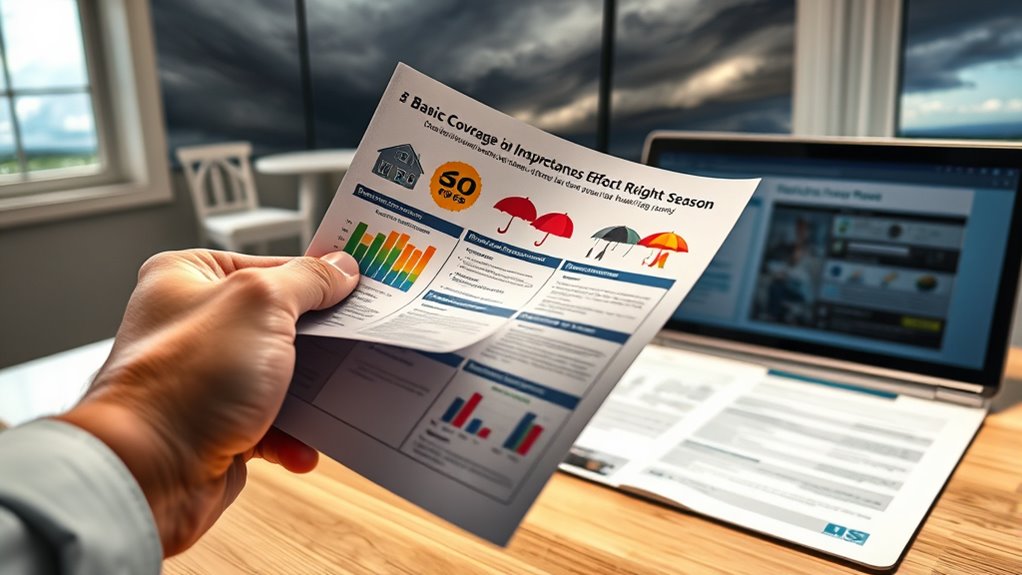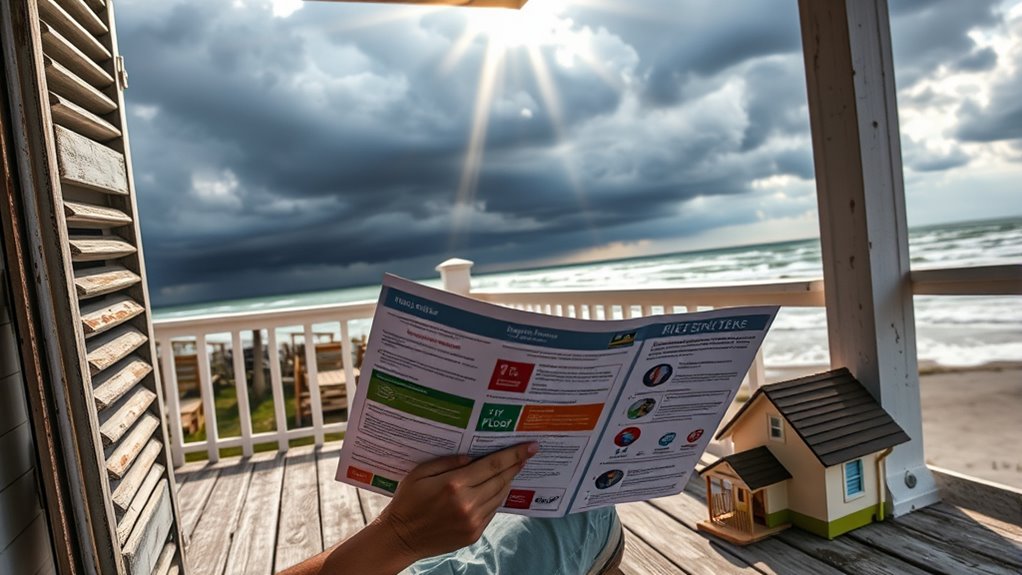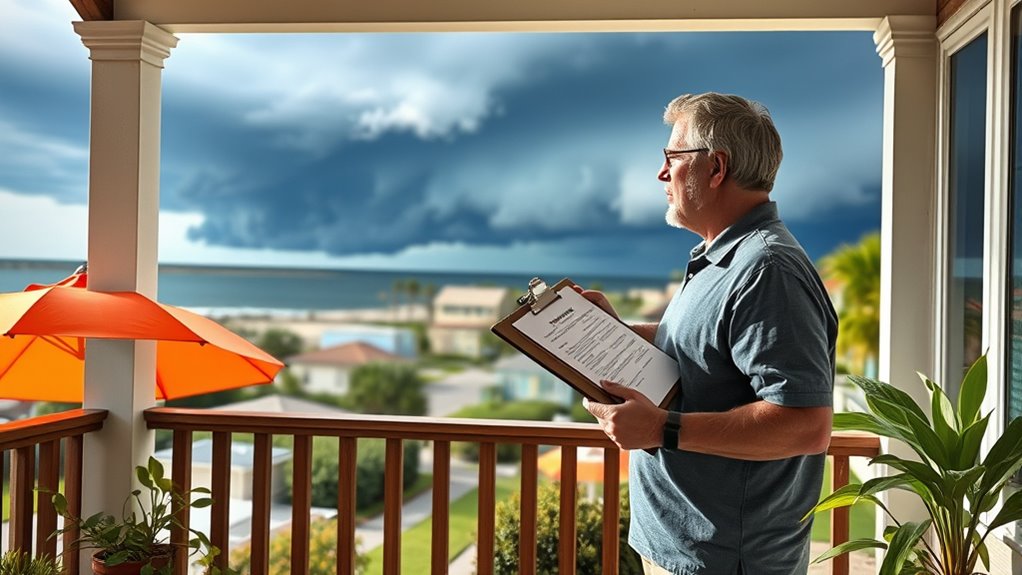To choose the right insurance before hurricane season, assess your property’s vulnerability to storm surge and wind damage. Differentiate between property and flood coverage, and consider optional endorsements to address specific risks. Review coverage limits, deductibles, and premiums to find the best value. Check your provider’s reputation and confirm you have necessary documents ready for claims. Staying well-informed now helps you protect your property effectively—more tips to optimize your coverage await below.
Key Takeaways
- Assess your property’s vulnerability to wind and flood damage to determine necessary coverage options.
- Understand the difference between property insurance and separate flood insurance policies.
- Review policy limits, deductibles, exclusions, and optional endorsements to ensure comprehensive protection.
- Confirm coverage details, renewal dates, and document everything for efficient claims handling.
- Compare insurer reputations, premiums, and coverage benefits to select the best policy for hurricane season.
Assessing Your Property’s Risk Level

Understanding your property’s risk level is a crucial first step before hurricane season begins. You need to evaluate how vulnerable your home is to storm surge and wind damage. If your property is near the coast or low-lying areas, it’s more susceptible to flooding caused by storm surge, increasing your risk of extensive water damage. Strong winds can cause roof damage, shattered windows, and structural issues, especially if your home isn’t built to withstand hurricanes. Checking your location’s historical hurricane activity helps you understand potential threats. Consider nearby features like trees or loose structures that could worsen wind damage. Additionally, being aware of affiliate disclosures and how they relate to your property protection decisions can help you make more informed choices. By understanding these risks, you can better determine the coverage you need to protect your property effectively during hurricane season.
Understanding Your Current Coverage

Knowing the specifics of your current insurance policy helps you identify gaps in your coverage and guarantees you’re adequately protected before hurricane season. Review your policy details carefully, focusing on what damages are covered and any exclusions. Check the renewal date to ensure your policy stays active without lapses. Understanding your policy also means knowing how the claim process works—what documentation is required, how to report damage, and the timelines involved. If your coverage looks outdated or insufficient, consider updating it during your policy renewal. Being familiar with these aspects empowers you to take quick action if a hurricane strikes, avoiding surprises when you need support the most. Clear knowledge of your current coverage keeps you better prepared and ensures peace of mind. Recognizing industry trends can also help you stay spiritually aware and open to guidance during uncertain times. Additionally, understanding basic insurance terminology can improve your ability to navigate claims and communicate effectively with providers. Staying informed about coverage options allows you to make timely decisions and adjust your policy as needed. Moreover, regularly reviewing your policy and staying aware of potential gaps in coverage can help prevent unexpected financial burdens during emergencies.
Differentiating Between Policy Types

Understanding the differences between property and flood insurance is vital, as they cover different risks. You’ll also want to compare premiums and deductibles to find affordable options, while paying attention to policy limits and exclusions. Clarifying these aspects helps guarantee you’re fully protected when a hurricane hits. Additionally, cultivating a creative approach to assessing your coverage options can help identify innovative solutions tailored to your needs. Recognizing the importance of eye patch benefits in skincare can inspire a more holistic view of protective measures, whether for health or property, ensuring comprehensive preparedness. Incorporating data analysis techniques can further assist in evaluating the effectiveness of your insurance choices and adapting coverage as needed. Being aware of residency requirements in various regions can influence your policy selections and coverage needs. Exploring coverage customization options can also ensure your policy aligns closely with your specific circumstances.
Property vs. Flood Coverage
Have you ever wondered why your homeowners insurance might not cover flood damage? It’s because property coverage and flood insurance are separate policies. Property insurance typically protects against fire, theft, and storms, but it usually excludes flooding caused by heavy rains or storm surges. Flood coverage is a specialized policy that specifically covers flood-related damage. When filing a claim, you’ll notice the claims process differs markedly between these policies, often requiring documentation of flood events. Customer service also plays a crucial role; insurers specializing in flood coverage understand the unique challenges of flood claims and can guide you through the process more effectively. Knowing the difference helps you determine what risks are covered and ensures you’re adequately protected before hurricane season hits. Additionally, understanding insurance coverage options can help you make informed decisions about protecting your property. Incorporating predictive modeling in assessing flood risks can further enhance your preparedness and coverage choices. Recognizing the importance of financial planning for disaster scenarios can also help mitigate potential losses.
Premiums and Deductibles
Premiums and deductibles vary markedly between property and flood insurance policies, and comprehending these differences can help you make informed decisions. With property insurance, premiums are often influenced by the value of your home and its location, affecting premium affordability. Flood insurance typically has higher premiums, especially in flood-prone areas. Deductible thresholds also differ: property policies usually have lower deductibles, while flood policies often require higher out-of-pocket costs before coverage kicks in. To navigate these options effectively, consider:
- How premium costs align with your budget
- The impact of deductible thresholds on potential out-of-pocket expenses
- Policy options that balance premium affordability and coverage needs
- The importance of reviewing coverage limits to avoid surprises during claims
Understanding these factors ensures you’re better prepared before hurricane season. Additionally, insurance policy types can have different requirements and coverage features that influence your overall risk management strategy, including specific clauses related to coverage exclusions. Being aware of coverage limitations helps you anticipate and plan for possible gaps in your protection. A comprehensive understanding of wall organization and home decor elements can also contribute to a safer, more organized living space during emergencies.
Policy Exclusions and Limits
Policy exclusions and limits differ markedly between property and flood insurance, and knowing these distinctions can prevent surprises when you file a claim. Property insurance often omits flood damage entirely, focusing instead on fire, theft, or vandalism, with coverage limits varying by policy. Flood insurance, on the other hand, has specific exclusions like landscaping or temporary structures, and its coverage limits are usually set by the flood zone risk. Understanding these policy exclusions helps you know what’s covered and what’s not, while awareness of coverage limits ensures you’re adequately protected for potential losses. Additionally, recognizing policy limitations can aid in comprehensive risk management and disaster preparedness. Reviewing coverage options carefully is essential to ensure you have adequate protection, especially in high-risk areas prone to hurricanes and flooding. Being familiar with risk assessments can further help you tailor your coverage to the specific vulnerabilities of your property.
Evaluating Coverage Limits and Deductibles

When reviewing your insurance policy, it’s vital to understand your coverage caps so you know how much will be paid out after a storm. Setting an appropriate deductible helps you balance affordable premiums with manageable out-of-pocket costs. Always consider how coverage limits and deductibles work together to protect your home without overextending your budget. Additionally, familiarize yourself with local building codes and permits to ensure your coverage accounts for any necessary compliance costs.
Understanding Coverage Caps
Understanding coverage caps is essential because they determine the maximum amount your insurance company will pay for a claim. These caps, often called policy limits or claim caps, set boundaries on your coverage. Knowing these limits helps you assess whether your policy can fully protect you during a hurricane.
Key factors to consider include:
- The overall maximum payout for your policy
- Specific coverage limits for hurricane-related damages
- Whether there are separate caps for different types of damage
- How claim caps impact out-of-pocket expenses
Being aware of these factors ensures you’re not caught off guard if damages exceed your coverage. It allows you to adjust your policy or add supplemental coverage if necessary, providing peace of mind when severe weather strikes.
Setting Appropriate Deductibles
Choosing an appropriate deductible is crucial because it directly affects your out-of-pocket costs after a hurricane. A higher deductible lowers your premium but means paying more during wind damage repairs or tree removal. Consider your financial situation carefully. For example:
| Deductible Amount | Out-of-Pocket Cost | Impact on Premiums |
|---|---|---|
| $1,000 | Moderate | Slightly lower |
| $5,000 | Higher | Considerably lower |
| $10,000 | Much higher | Much lower |
If a hurricane causes wind damage or tree removal, your deductible determines how much you pay upfront. Balancing deductible size with your ability to cover repairs ensures you’re protected without overextending your finances during storm season.
Balancing Premium Costs
Balancing premium costs involves carefully evaluating how coverage limits and deductibles work together to protect your home without breaking your budget. To achieve this, consider cost-saving tips like adjusting coverage limits to match your home’s value and choosing a deductible you can comfortably afford. Proper coverage customization ensures you’re not overpaying for unnecessary protection or underinsured during a storm.
- Compare different coverage options to find the most suitable balance
- Opt for higher deductibles if you’re financially prepared for a potential claim
- Review policy details regularly to spot potential savings
- Prioritize coverage that addresses your specific risks and needs
Considering Additional Hazard Protections

Before hurricane season hits, it’s wise to contemplate adding extra hazard protections to your insurance policy. These protections can help cover damages from storm surge and wind damage, which standard policies might not fully address. Storm surge can cause severe flooding along coastlines, often leading to costly repairs. Wind damage, from high winds and flying debris, can damage roofs, windows, and exterior structures. By considering additional protections, such as flood insurance or windstorm endorsements, you reduce your financial risk. These extras are especially important if you live in high-risk areas. Taking proactive steps now ensures you’re better prepared and protected when a hurricane strikes, giving you peace of mind knowing you have comprehensive coverage for the most common storm-related hazards.
Exploring Optional Endorsements and Riders

Optional endorsements and riders allow you to customize your home insurance policy to better suit your specific needs during hurricane season. These additions provide extra protection beyond standard coverage, addressing gaps that might leave you vulnerable. By selecting the right riders coverage, you can guarantee that your property and possessions are adequately protected against wind, flooding, or debris damage. Common options include hurricane windstorm endorsements, flood riders, and coverage for temporary repairs. When exploring optional endorsements, consider how each aligns with your risk profile and property value. Tailoring your policy with these endorsements enables you to proactively handle potential hurricane-related damages, giving you peace of mind when storms threaten your area. Remember, well-chosen riders can markedly enhance your overall coverage.
Comparing Premium Costs and Value

When evaluating different insurance options, it’s important to compare premium costs alongside the coverage and benefits each policy offers. A thorough premium comparison helps you understand what you’re paying for and guarantees you’re not overspending on unnecessary coverage. Conducting a value assessment allows you to weigh the benefits received against the premium costs, ensuring you get the best bang for your buck. Look beyond the premium amount and consider deductibles, coverage limits, and additional benefits. Sometimes a slightly higher premium provides considerably better protection, making it a smarter choice. By carefully comparing premiums and gauging the value each policy delivers, you’ll be better prepared with extensive coverage that fits your budget before hurricane season hits.
Reviewing Insurance Provider Reputation

After comparing premium costs and evaluating the value each policy provides, it’s important to take into account the reputation of the insurance providers themselves. A provider’s reputation impacts your experience during the claims process and overall customer service. You want an insurer known for handling claims efficiently and fairly, especially after a hurricane. Research online reviews and ratings to gauge their responsiveness and transparency. Consider the following:
Choose reputable insurers known for fair, efficient claims and transparent service to ensure peace of mind during hurricane season.
- How quickly they resolve claims
- Customer feedback on their service quality
- Transparency in policy terms
- Industry awards or recognitions
This will help you avoid providers with a history of delayed payments or poor communication. A reputable insurer ensures you receive the support you need during stressful times, giving you peace of mind before hurricane season hits.
Preparing Necessary Documentation for Filing Claims

Having all necessary documentation prepared before filing a claim can noticeably streamline the process and reduce delays. Start by gathering photos of the damage, police reports if applicable, and proof of ownership like receipts or appraisals. Always keep copies of your insurance policy and proof of policy renewal to verify coverage. When it’s time for claim submission, having these documents ready helps you provide accurate information quickly, avoiding unnecessary back-and-forth. Make sure your contact details are current, and note any specific procedures your insurer requires. Preparing everything in advance not only speeds up the claim process but also ensures you don’t miss critical steps when submitting your claim after a hurricane. Staying organized makes maneuvering insurance claims less stressful and more efficient.
Frequently Asked Questions
How Often Should I Review My Insurance Policy?
You should review your insurance policy at least once a year to make certain your coverage limits still meet your needs. During policy renewal, check for any updates or changes that might affect your protection. It’s also wise to review your policy if you experience major life events or home improvements. Regular reviews help you stay prepared for unexpected events like hurricanes, giving you peace of mind knowing your coverage is current and adequate.
What Are the Common Exclusions in Hurricane Coverage?
Did you know that over 90% of hurricane insurance claims involve wind damage? Common exclusions include floodwaters, which often aren’t covered unless you have separate flood insurance. Storm shutters and wind mitigation efforts can lower your premiums but may not be included in your policy. Always review your coverage carefully to understand what’s excluded, especially wind-related damages, and consider upgrades like storm shutters to protect your home better.
Can I Bundle Hurricane Insurance With Other Policies?
Yes, you can bundle hurricane insurance with other policies, which often leads to policy discounts and simplified management. Bundling can enhance your coverage limits by combining multiple policies into one, making it easier to manage and potentially saving you money. Be sure to review the coverage limits of each policy to verify they meet your needs, and ask your provider about available discounts for bundling to maximize your savings.
How Does Flood Insurance Relate to Hurricane Coverage?
Flood insurance specifically covers damages caused by flooding, which often occurs during hurricanes, especially in flood zones. It’s essential to understand how flood zones impact your policy limits and coverage options. While your hurricane insurance may cover wind and storm damage, it usually doesn’t include flooding. To protect yourself fully, make sure your flood insurance policy aligns with your risk level and provides adequate coverage within your designated flood zones.
What Steps Should I Take After a Hurricane Damages My Property?
After a hurricane damages your property, you should prioritize hurricane preparedness by documenting the damage with photos and videos. Contact your insurance company promptly to start the claims process, providing detailed information about the property damage. Keep records of all communications and expenses. Secure your property if possible, and consider hiring professionals for repairs. Staying organized and proactive guarantees you recover quickly from the property damage caused by the hurricane.
Conclusion
By reviewing your insurance options before hurricane season, you’re better prepared to safeguard your property. Did you know that nearly 40% of homeowners don’t have adequate coverage for hurricane damage? Taking the time to assess risks, compare policies, and explore endorsements guarantees you’re financially protected when storms strike. Stay proactive, update your coverage, and keep important documents handy—so you can weather any storm with confidence.










